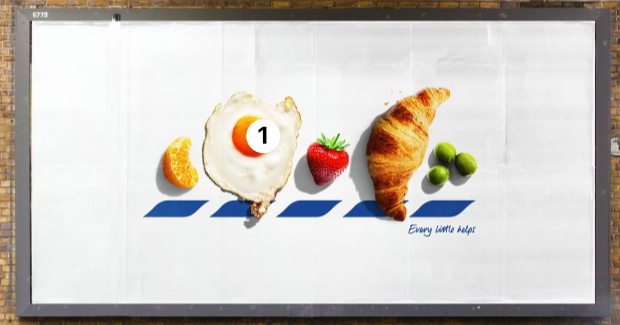Does the “Generation Effect” in Advertising Still Work?
Two weeks ago, UK supermarket chain Tesco unveiled an ad campaign that became an immediate darling of marketeers—and likely puzzled the bulk of the public. Abandoning its logo—aside from its classic blue chevrons—Tesco instead substituted staples from its shelves for each of the letters in its name.
Can you name the second, third, and fifth items in this ad? Source: Bartle Bogle Hegarty, London
The resulting ad campaign requires passersby to identify each food item correctly to spell out the company’s name: TESCO. Marketeers likely thought UK consumers would appreciate the cleverness of the ad campaign while also noticing and recalling it more than they would an ordinary appeal that left little to consumers’ imaginations. When readers must supply at least part of the message, they typically display better recall, courtesy of the well-established generation effect.
What about the first three items here?
Source: Bartle Bogle Hegarty, London
The most widely-cited study on the generation effect attests to its power. However, that study also omits pictures, using rhymes, anagrams, and word completion among its challenges. Similarly, another study of the generation effect noted that readers had stronger recall of unfamiliar than they did of familiar words. Theoretically, readers will recall TESCO more clearly if they have to work to supply “Edam,” rather than merely “cheese,” although UK readers are likelier to also founder on the the leafy bunch that forms the first letter and guess “watercress,” rather than “thyme.”
British companies frequently pitch advertisements that win marketing awards, based on an assumed widely shared cultural understanding. For instance, for decades, UK Sunday trading laws famously still restrict which retailers can open on Sundays, and even what they can sell—peculiarly, consumers could once buy porn but not bibles—despite shrinking church attendance or even a majority of population that devoutly practice Christianity.
However, your average commuter on the Tube is unlikely to correctly identify raw tuna or edamame, although the barely legible Tesco slogan, Every little helps, could nudge a reader into recognition. Or, at least, prompt a discussion online with someone who also wonders what that ad was about. Provided your average consumer recalls one ad amidst the deluge of ads daily on their phones, desktops, and watches.
What about the first, second, and final item in this ad?
Source: Bartle Bogle Hegarty, London
Do Generation Effects Exist Outside the Lab?
So what about the generation effect, which argues that readers recall unfamiliar content they generate far better than supplied content? Significantly, generation effects fail to apply to low-frequency or non-words. In addition, marketeers should recall that generation effects stem entirely from decades of studies, conducted mostly by psychology and marketing faculty on highly literate undergraduate and graduate students. (See, for example, Nairne, Pusen & Widner, 1985; Slamecka & Katsaiti, 1987;McCurdy et al., 2020). As a result, the outcomes of these laboratory-based, highly constrained experiments might fail to translate to your average pedestrian walking past the ads—let alone while probably intently scrolling on a smartphone.
Moreover, even studies of the generation effect attest to its profound limitations. For instance, in one landmark study, researchers discovered that, when experiments mixed completed and incomplete or scrambled words in separate lists, the generation effect vanished. Thus, the generation effect stems from participants allocating more time to generate incomplete items than they require for complete items. Moreover, the complete-incomplete tradeoff resulted in participants failing to recall complete items because of subjects' more intensive focus on generated items.
What about the first and second items in this ad?
Source: Bartle Bogle Hegarty, London
For marketeers, unfortunately, the generation effect may well be a mirage created by the academic laboratory conditions for most of the studies that have attested to its impact on memorability. Significantly, studies have failed to find significant generation effects outside laboratory settings. A clever ad featuring unfamiliar foods that require close scrutiny and identification may prove illegible to shoppers who can’t tell a slice of Edam from a white cheddar—and are unable to afford either.
Ultimately, Tesco’s ads are likely more an amusing dog whistle to existing Tesco shoppers, given the widening rift between Brits who can afford to shop at the upmarket chain and the “working people” wondering when the next round of austerity will begin.
This ad might be more legible, provided you realize the final item is olives, not limes.
Source: Bartle Bogle Hegarty, London





